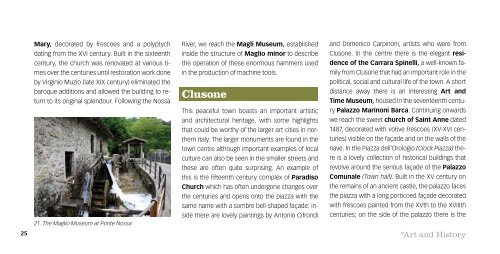Bike Tours
Bike Tours
Bike Tours
Create successful ePaper yourself
Turn your PDF publications into a flip-book with our unique Google optimized e-Paper software.
25<br />
Mary, decorated by frescoes and a polyptych<br />
dating from the XVI century. Built in the sixteenth<br />
century, the church was renovated at various times<br />
over the centuries until restoration work done<br />
by Virginio Muzio (late XIX century) eliminated the<br />
baroque additions and allowed the building to return<br />
to its original splendour. Following the Nossa<br />
21. The Maglio Museum at Ponte Nossa<br />
River, we reach the Magli Museum, established<br />
inside the structure of Maglio minor to describe<br />
the operation of these enormous hammers used<br />
in the production of machine tools.<br />
Clusone<br />
This peaceful town boasts an important artistic<br />
and architectural heritage, with some highlights<br />
that could be worthy of the larger art cities in northern<br />
Italy. The larger monuments are found in the<br />
town centre although important examples of local<br />
culture can also be seen in the smaller streets and<br />
these are often quite surprising. An example of<br />
this is the fifteenth century complex of Paradiso<br />
Church which has often undergone changes over<br />
the centuries and opens onto the piazza with the<br />
same name with a sombre bell-shaped façade: inside<br />
there are lovely paintings by Antonio Cifrondi<br />
and Domenico Carpinoni, artists who were from<br />
Clusone. In the centre there is the elegant residence<br />
of the Carrara Spinelli, a well-known family<br />
from Clusone that had an important role in the<br />
political, social and cultural life of the town. A short<br />
distance away there is an interesting Art and<br />
Time Museum, housed in the seventeenth century<br />
Palazzo Marinoni Barca. Continuing onwards<br />
we reach the sweet church of Saint Anne dated<br />
1487, decorated with votive frescoes (XV-XVI centuries)<br />
visible on the façade and on the walls of the<br />
nave. In the Piazza dell’Orologio (Clock Piazza) there<br />
is a lovely collection of historical buildings that<br />
revolve around the serious façade of the Palazzo<br />
Comunale (Town hall). Built in the XV century on<br />
the remains of an ancient castle, the palazzo faces<br />
the piazza with a long porticoed façade decorated<br />
with frescoes painted from the XVth to the XVIIIth<br />
centuries; on the side of the palazzo there is the<br />
*Art and History

















